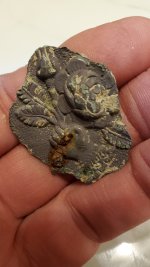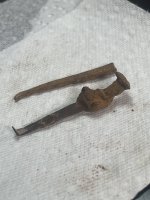bigscoop
Gold Member
- Jun 4, 2010
- 13,373
- 8,689
- Detector(s) used
- Older blue Excal with full mods, Equinox 800.
- Primary Interest:
- All Treasure Hunting
For the sake of this thread, let us assume in our considerations and replies that the story in the Beale Pamphlet is true, that thirty men did in fact find themselves mining gold somewhere northwest of Santa Fe, presumably somewhere in Colorado. Let us forget the points of argument against the possibility of such an event, and for this thread let us assume that it really happened. So operating within these perimeters, what are we really looking at?
First, at the time of their mining activities they would have been operating in Spanish territory illegally. This being something that everyone can agree on. And second, this activity would have taken place at precisely the same time as the Adams Onis Treaty, a critical circumstance overshadowing the party's mining activities, and the following is why.
The effected region in Colorado was to become an area of great debate during the Adams Onis Treaty, the outcome of this treaty possibly determining whether the party would have to continue its mining in an illegal situation. So if the party's mining operation was within this area of debated borders then the outcome of the Adams Onis Treaty would have weighed heavily on the party's mining future. In other words, depending on where those agreed boundary lines would be established also determining whether the party could become a legitimate business enterprise on US soil or whether it would have to remain an illegal operation. Now with all of this in mind this could also explain the reason for the secret deposits and the ten year term.
Prior to 1821 the party, in essence, would have been stealing from Spain and if Spain had learned of this theft even after the wealth had been transferred back to the east they still would have retained legal claim over it. So, perhaps, this is the reason why the first shipment was sent back east in 1819 shortly after the treaty's signing? Perhaps the party got word that their mine would indeed remain on Spanish lands even after the new borders had been established. If this were the case it would have presented a most troubling circumstance.
And this is where things become quite interesting because if this was the case then it would also mean that the party was well enough connected to have been kept abreast of the treaty negotiations. In 1821 the second shipment is sent back east shortly after the treaty's ratification, the ten year term now being attached to this secret stash of illegally harvested Spanish wealth. But only now the situation is worse then before, the terms of that treaty specifically stating that Spain would retain ownership of all of her possessions. Even today we see this same forfeiture of Spanish wealth that is discovered in US territories, Spain still retaining the right of ownership. Also, the terms of the agreement allowed for no spoliation claim on behalf of the party because they had been, and were, operating illegally in the first place. All of this presents quite a legally messy web that may have possibly been weaved.
And here's the thing, new evidence suggest that, at the very least, this scenario might have been possible. And when we consider the ten year term and the flame that was worth the candle, well, perhaps the picture being painted is even much broader then the possibility presented thus far. Perhaps, and this is just an interesting sidebar, but perhaps the ten year term was set in place with the filibusterers in mind. How preposterous, you might have just claimed. But perhaps not, so read on.
There were many Americans who were strongly against the negotiating of any treaty that limited the American right of expansion into the west, this ultimately being the reason for the filibusters in the first place. So, and going back to our earlier possibility involving the party's unfortunate state of affairs, what if they had stashed that wealth with the hope, or knowledge, that the agreed borders and terms in the Adams Onis Treaty wouldn't stand. What if they established the ten year term based on this hope, or knowledge?
Now, and just as one poster here continues to point out the extended Risque family tree, I leave the rest to you to surmise the possibilities. Perhaps, there's far more here then meets the eye. Maybe, just maybe, it really happened? And when we really extend that family tree, to the furthest extremes of its existence, guess who was part of it? Here was the brother of someone who had married into the Buford & Otey bloodline. Yep, if we look deep enough and far enough we find, Thomas Beale.
First, at the time of their mining activities they would have been operating in Spanish territory illegally. This being something that everyone can agree on. And second, this activity would have taken place at precisely the same time as the Adams Onis Treaty, a critical circumstance overshadowing the party's mining activities, and the following is why.
The effected region in Colorado was to become an area of great debate during the Adams Onis Treaty, the outcome of this treaty possibly determining whether the party would have to continue its mining in an illegal situation. So if the party's mining operation was within this area of debated borders then the outcome of the Adams Onis Treaty would have weighed heavily on the party's mining future. In other words, depending on where those agreed boundary lines would be established also determining whether the party could become a legitimate business enterprise on US soil or whether it would have to remain an illegal operation. Now with all of this in mind this could also explain the reason for the secret deposits and the ten year term.
Prior to 1821 the party, in essence, would have been stealing from Spain and if Spain had learned of this theft even after the wealth had been transferred back to the east they still would have retained legal claim over it. So, perhaps, this is the reason why the first shipment was sent back east in 1819 shortly after the treaty's signing? Perhaps the party got word that their mine would indeed remain on Spanish lands even after the new borders had been established. If this were the case it would have presented a most troubling circumstance.
And this is where things become quite interesting because if this was the case then it would also mean that the party was well enough connected to have been kept abreast of the treaty negotiations. In 1821 the second shipment is sent back east shortly after the treaty's ratification, the ten year term now being attached to this secret stash of illegally harvested Spanish wealth. But only now the situation is worse then before, the terms of that treaty specifically stating that Spain would retain ownership of all of her possessions. Even today we see this same forfeiture of Spanish wealth that is discovered in US territories, Spain still retaining the right of ownership. Also, the terms of the agreement allowed for no spoliation claim on behalf of the party because they had been, and were, operating illegally in the first place. All of this presents quite a legally messy web that may have possibly been weaved.
And here's the thing, new evidence suggest that, at the very least, this scenario might have been possible. And when we consider the ten year term and the flame that was worth the candle, well, perhaps the picture being painted is even much broader then the possibility presented thus far. Perhaps, and this is just an interesting sidebar, but perhaps the ten year term was set in place with the filibusterers in mind. How preposterous, you might have just claimed. But perhaps not, so read on.
There were many Americans who were strongly against the negotiating of any treaty that limited the American right of expansion into the west, this ultimately being the reason for the filibusters in the first place. So, and going back to our earlier possibility involving the party's unfortunate state of affairs, what if they had stashed that wealth with the hope, or knowledge, that the agreed borders and terms in the Adams Onis Treaty wouldn't stand. What if they established the ten year term based on this hope, or knowledge?
Now, and just as one poster here continues to point out the extended Risque family tree, I leave the rest to you to surmise the possibilities. Perhaps, there's far more here then meets the eye. Maybe, just maybe, it really happened? And when we really extend that family tree, to the furthest extremes of its existence, guess who was part of it? Here was the brother of someone who had married into the Buford & Otey bloodline. Yep, if we look deep enough and far enough we find, Thomas Beale.





